Single-mode Fibers
Acronym: SMF
Definition: optical fibers supporting only a single guided mode per polarization direction
Alternative term: monomode fibers
More general term: optical fibers
Opposite term: multimode fibers
German: einmodige Fasern
Category: fiber optics and waveguides
How to cite the article; suggest additional literature
Author: Dr. Rüdiger Paschotta
Single-mode fibers (also called monomode fibers) are optical fibers which are designed such that they support only a single propagation mode (LP01) per polarization direction for a given wavelength. Higher-order modes like LP11, LP20 etc. then do not exist – only cladding modes, which are not localized around the fiber core. Single-mode fibers usually have a relatively small core (with a diameter of only a few micrometers) and a small refractive index difference between core and cladding. The mode radius is typically a few microns. However, there are also large mode area fibers with a relatively large mode area.
A peculiar property of single-mode fibers is that the transverse intensity profile at the fiber output has a fixed shape, which is independent of the launch conditions and the spatial properties of the injected light, assuming that no cladding modes can carry substantial power to the fiber end. The launch conditions only influence the efficiency with which light can be coupled into the guided mode.
Intermodal dispersion can of course not occur in single-mode fibers. This is an important advantage for the application in optical fiber communications at high data rates (multiple Gbit/s), particularly for long distances. Essentially for that reason, and partly because of their tentatively lower propagation losses, single-mode fibers are exclusively used for long-haul data transmission, and nearly always for outdoor applications even over shorter distances. For short-distance indoor use, multimode fibers are more common, mostly because that allows the use of cheaper multimode data transmitters based on light-emitting diodes instead of laser diodes.
Conditions for Efficiently Launching Light into a Single-mode Fiber
Efficiently launching light into a single-mode fiber requires that the transverse complex amplitude profile of that light at the fiber's input end matches that of the guided mode. This implies
- that the light source has a high beam quality (with M2 ≈ 1)
- that the light has a focus at the fiber's input end (for matching the plane wavefronts of the fiber mode)
- that the beam profile has the correct size and shape and is precisely aligned (concerning position and direction) to the core. More precisely, the error in position must be well below the beam radius, and the angular misalignment must be small compared with the beam divergence of the mode.
In practice, it is not always easy to align the optics for efficient launching into a single-mode fiber. One may even have difficulties finding the position of the often rather small fiber core to which the input beam must be focused. (For large mode area fibers, that task is simpler, but on the other hand the angular tolerances are tighter.) One usually does the alignment while watching the optical power throughput of the fiber with a photodetector at the output fiber end, assuming that only light launched into the fiber core can reach that detector (which may not be true when the fiber is rather short). It is helpful to have a high-quality fiber launch system for such purposes.
Generally, a long-term stable efficient launch of a free-space laser beam into a single-mode fiber requires well designed mechanical parts, which allow to precisely align and keep fixed the focusing lens and the fiber end while not exhibiting excessive thermal drifts.
The launch efficiency under non-ideal conditions, namely with a wrong laser beam size or wrong angular alignment, can be calculated with equations as given in the article on fiber joints.
Conditions for Single-mode Guidance
For step-index fibers, the condition for single-mode guidance can be formulated using the V number (normalized frequency), which can be calculated from the wavelength, the core radius, and the numerical aperture (NA): the V number must be below ≈ 2.405 [2]. This requires that the core radius is small, particularly for fibers with high NA.
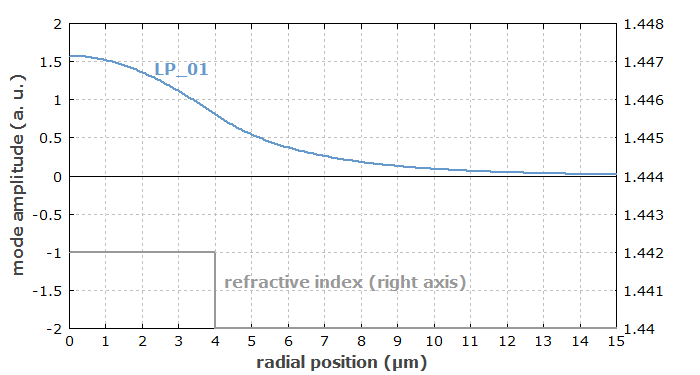
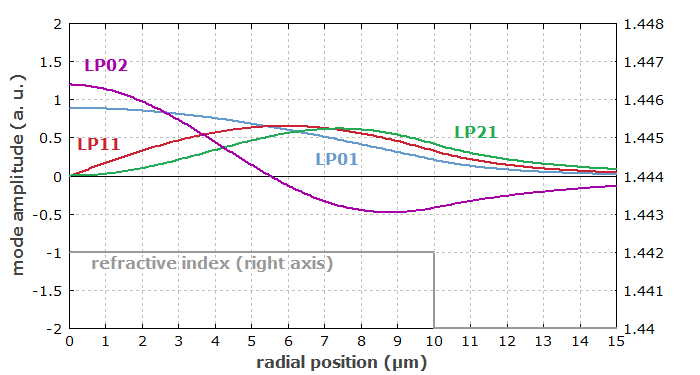
Typically, a fiber has single-mode characteristics only over a limited wavelength range with a width of a few hundred nanometers. The limit towards smaller wavelengths is given by the single-mode cut-off wavelength, beyond which the fiber supports multiple modes. This transition is very sharp and can easily be seen e.g. when tuning the launched wavelength around the cut-off wavelength: the shape of the transmitted beam varies rapidly in the multimode regime but remains constant in the single-mode regime. The long-wavelength limit of the useful single-mode region is usually given by excessive bend losses, by absorption of the material or (for certain fiber designs, e.g. with index-depressed cladding) by leakage into the cladding.
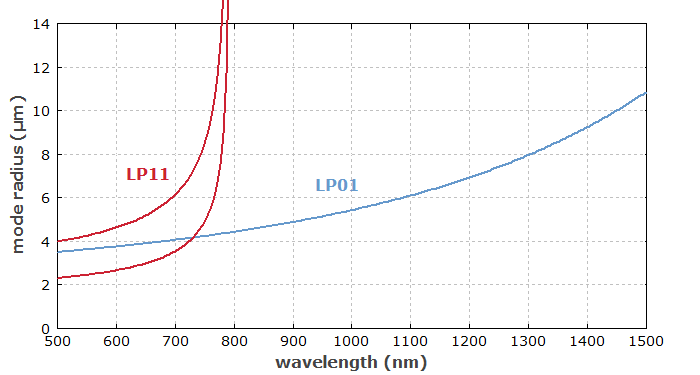
Figure 4 shows how light evolves when it is launched into the left end of a single-mode fiber with a slightly misaligned laser beam. Initially, some of the light gets into cladding modes, which however are attenuated substantially. After some length, mostly light in the guided mode remains.
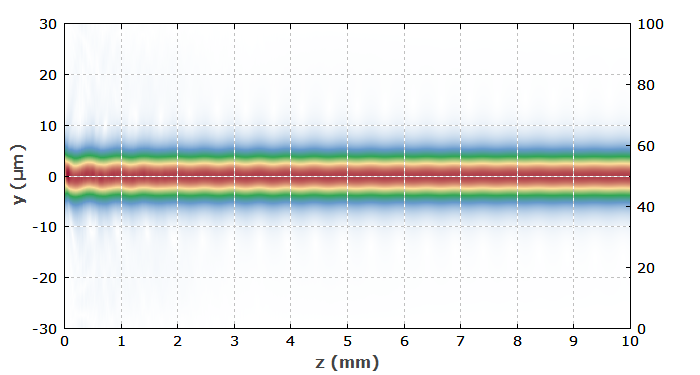
For a shorter wavelength (Figure 5]), the fiber gets into the slightly multimode regime: in addition to the LP01 mode, there are now two LP11 modes. Here, one obtains a periodic oscillation of the field profile due to mode interference.
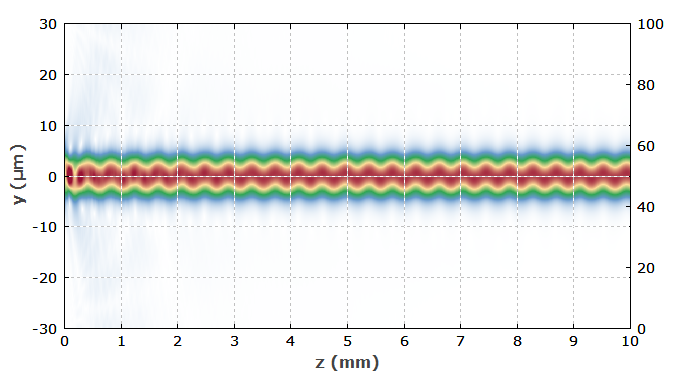
For a still shorter wavelength of 0.5 μm (see Figure 6), the propagation gets more complicated, since the fiber supports more modes.
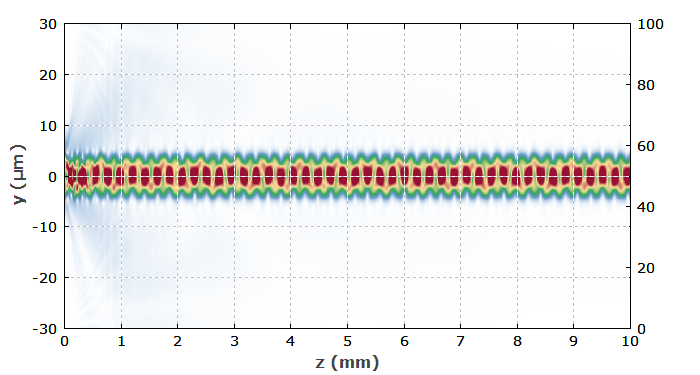
Note that mode interferences can be affected by any effects acting on the propagation constants of the modes. For example, even slight bending would affect the phase relationship of the modes. Also, the beam profiles are strongly wavelength-dependent. All these effects are not observed in single-mode fibers.
Photonic crystal fibers can have substantially broader or narrower wavelength regions with single-mode propagation. For example, there are endlessly single-mode fibers with a very wide single-mode wavelength region. On the other hand, there are photonic bandgap fibers with narrow single-mode regions and no guidance at other wavelengths.
ITU Standards for Single-mode Fibers
The International Telecommunications Union (ITU) has developed a number of standards for various types of fibers as used for optical fiber communications. Some of the most important of those standards concerning single-mode fibers are given in Table 1.
Table 1: Standards for single-mode fibers.
| Name | Title |
|---|---|
| G.650.1 (06/04) | Definitions and test methods for linear, deterministic attributes of single-mode fibre and cable |
| G.652 (06/05) | Characteristics of a single-mode optical fibre and cable |
| G.653 (12/06) | Characteristics of a dispersion-shifted single-mode optical fibre and cable |
| G.654 (12/06) | Characteristics of a cut-off shifted single-mode optical fibre and cable |
| G.655 (03/06) | Characteristics of a non-zero dispersion-shifted single-mode optical fibre and cable |
| G.656 (12/06) | Characteristics of a fibre and cable with non-zero dispersion for wideband optical transport |
| G.657 (12/06) | Characteristics of a bending loss insensitive single mode optical fibre and cable for the access network |
Large Mode Area Single-mode Fibers and Effectively Single-mode Fibers
For some applications, single-mode fibers with relatively large core diameters of tens of micrometers (→ large mode area fibers) are required. This can be achieved in different ways, e.g. by making a large core with a small index difference (small numerical aperture), or with a photonic crystal fiber. In general, single-mode fibers with large mode areas tend to be more sensitive to bend losses, compared with multimode fibers, because the guiding is relatively weak.
In some cases, strictly single-mode guidance is not required; it is possible to use effectively single-mode fibers, having a few transverse modes, where however all higher-order modes have relatively high losses, and mode coupling from the fundamental mode to higher-order modes is weak. Some bending of the fiber is often used to suppress higher-order modes more efficiently, if they exhibit higher bend losses.
Applications
Single-mode guidance is important for many applications. Examples are:
- In fiber lasers and amplifiers made of rare-earth-doped fibers, single-mode guidance is the basis for achieving a high beam quality of the output.
- In optical fiber communication systems, single-mode guidance avoids the problem of intermodal dispersion, which (in multimode fibers) would lead to the occurrence of multiple copies of the input signals at the receiver.
- Single-mode fibers are used for connecting different components in fiber-optic setups, such as interferometers. They can be fusion-spliced or put together with fiber connectors.
- In measurement setups, the fact is often exploited that the output of a single-mode fiber has a fixed spatial shape, independent of the launch conditions. A single-mode fiber may serve as a kind of mode cleaner.
- Nonlinear interactions in long single-mode fibers may be exploited. For example, this can be signal amplification via stimulated Raman scattering, or strong spectral broadening (supercontinuum generation).
As a standard single-mode fiber for use in optical fiber communications in the 1.3-μm or 1.5-μm wavelength region, the SMF-28 of Corning (or the enhanced version SMF-28e) is common. This has a core diameter of 8.2 μm and a numerical aperture of 0.14. The mode field diameter is ≈ 9.2 μm at 1310 nm, or 10.4 μm at 1550 nm. The single-mode cut-off is at ≈ 1260 nm.
Suppliers
The RP Photonics Buyer's Guide contains 36 suppliers for single-mode fibers. Among them:

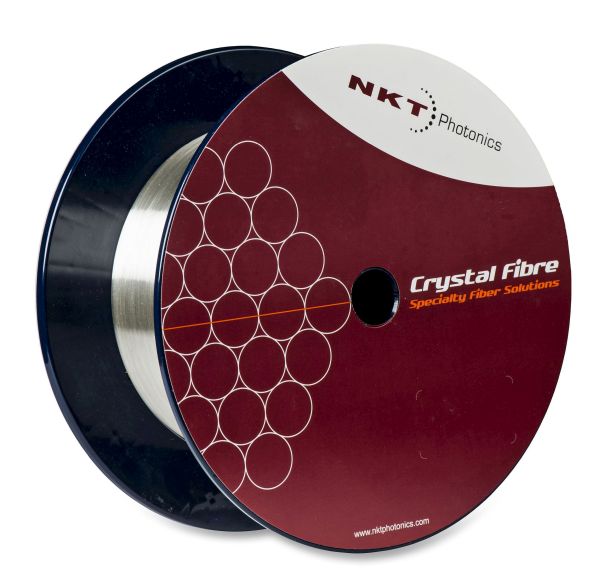
NKT Photonics
NKT Photonics offers several types of broadband (UV–nIR) single-mode polarization-maintaining fibers with large mode area. They are also available with collimators and alignment mechanics as complete fiber delivery solutions.

Schäfter + Kirchhoff
We offer single-mode fiber cables with different cut-off wavelengths and measured values for the effective fiber NA.
Questions and Comments from Users
Here you can submit questions and comments. As far as they get accepted by the author, they will appear above this paragraph together with the author’s answer. The author will decide on acceptance based on certain criteria. Essentially, the issue must be of sufficiently broad interest.
Please do not enter personal data here; we would otherwise delete it soon. (See also our privacy declaration.) If you wish to receive personal feedback or consultancy from the author, please contact him e.g. via e-mail.
By submitting the information, you give your consent to the potential publication of your inputs on our website according to our rules. (If you later retract your consent, we will delete those inputs.) As your inputs are first reviewed by the author, they may be published with some delay.
Bibliography
| [1] | K. C. Kao and G. A. Hockham, “Dielectric-fibre surface waveguides for optical frequencies”, Proc. IEEE 113 (7), 1151 (1966) |
| [2] | D. Gloge, “Weakly guiding fibers”, Appl. Opt. 10 (10), 2252 (1971), doi:10.1364/AO.10.002252 |
| [3] | K. Jürgensen, “Dispersion-optimized optical single-mode glass fiber waveguides”, Appl. Opt. 14 (1), 163 (1975), doi:10.1364/AO.14.000163 |
| [4] | S. B. Poole, D. N. Payne and M. E. Fermann, “Fabrication of low loss optical fibers containing rare earth ions”, Electron. Lett. 21, 737 (1985), doi:10.1109/JLT.1986.1074811 |
| [5] | S. B. Poole et al., “Fabrication and characterization of low-loss optical fibers containing rare earth ions”, J. Lightwave Technol. 4 (7), 870 (1986), doi:10.1109/JLT.1986.1074811 |
| [6] | R. Paschotta, tutorial on "Passive Fiber Optics", Part 3: Single-mode Fibers |
| [7] | Standards of the International Telecommunication Union (ITU), see http://www.itu.int/ |
See also: fibers, numerical aperture, V number, mode radius, multimode fibers, cut-off wavelength, waveguides, mode matching, effective mode area, The Photonics Spotlight 2008-02-22
and other articles in the category fiber optics and waveguides
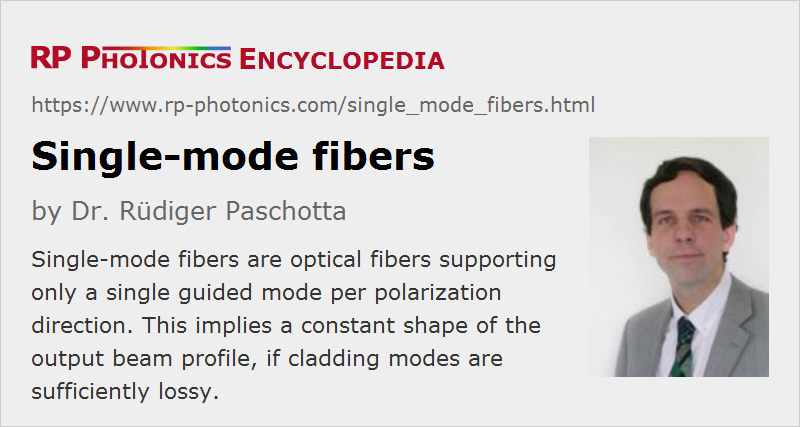 |






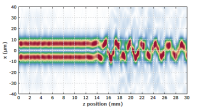
If you like this page, please share the link with your friends and colleagues, e.g. via social media:
These sharing buttons are implemented in a privacy-friendly way!